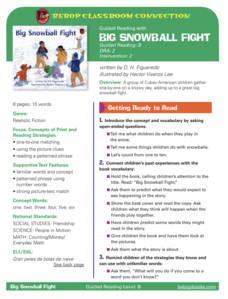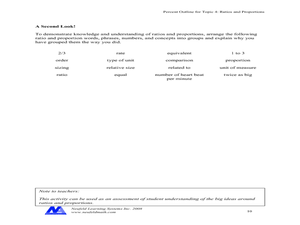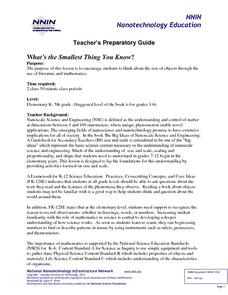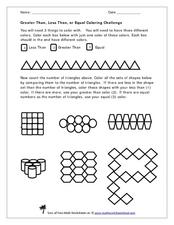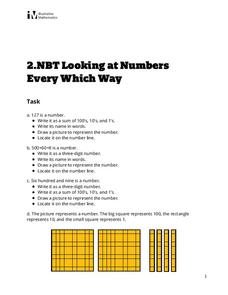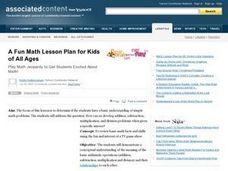TED-Ed
A-rhythm-etic. The Math Behind the Beats
Your learners will dance in their seats as this talented drummer connects math to music in a short video clip. Clayton Cameron shows how math puts the "cool" in various genres of music, including jazz, hip-hop, pop, R&B, and others,...
K5 Learning
Addition and Subtraction Word Problems #1
Third graders read and solve six word problems and decide whether to add or subtract. The numbers range in 2-digit up to 4-digit.
Balanced Assessment
A Run for Two
Develop a graph to represent the distance between two cars. The assessment task presents a scenario in which two cars are traveling at constant speeds with one faster than the other. Pupils develop graphical representations to show the...
Math in English
Grade 5 Fractions Word Problems
Young mathematicians apply their fractions skills in the real world with this simple word problem worksheet.
Curated OER
Biospheres in Your Backyard
Students collect data from a local river biome. They use the information for metric conversion and graphing equations. They study the components of what makes up a biosphere and how math is used to analyze one.
Curated OER
Big Snowball Fight
Students complete pre reading, writing, during reading, and interdisciplinary activities for the book Big Snowball Fight. In this reading lesson plan, students complete journal entries, answer short answer questions, have discussions,...
BBC
Counting in French: Numbers 7 - 12
Counting from seven to twelve in French is the foundational skill of a lesson from the BBC. Learners respond in French to the question, "How much is that?" (Ça fait combien?). The "Notes" and "Reinforcement" sections have inventive...
Curated OER
The Big Bang Theory
Students explore the Big Bang Theory and discover how it can be used to explain the origin of the universe. For this Big Bang Theory lesson, students use a balloon with colored paper inside, blow it up and pop it, group the colored...
Houghton Mifflin Harcourt
Sums to 100
Whether it's counting marbles, flowers, or playing cards, small objects can add up to great sums. Learners work six story problems to practice addition to 100. Some regrouping is required, along with distinguishing useful from irrelevant...
University of Colorado
Looking Inside Planets
Researchers use scientific data to understand what is inside each of the planets. The first in a series of six, this instructional activity builds off of that concept by having pupils use a data table to create their own scale models of...
Denver Public Schools
Kung-hsi Fa-ts' ai! – A Chinese New Year Celebration
Looking for ideas for your Lunar New Year celebration? Check out an interdisciplinary unit of study that includes lessons in counting, calligraphy, culture, geography, literature, art, and music. Kung-hsi Fa-ts' ai! (May you become rich!)
Curated OER
Building Big Ideas in Math: Frog Themed
In this math patterns worksheet, students work to find the math pattern in 'The Lost Button' story. Students answer six questions about math patterns.
Curated OER
Math Jeopardy
Students, in teams, play Math Jeopardy against each other as a way to reinforce their skills.
Neufeld Learning Systems
Concept: Ratios and Proportions
Upper elementary and middle school pupils fill out a chart creating six equivalent fractions and then compare them to six different objects and/or shapes. They group together 16 various terms related to ratios and proportions. Pupils...
National Nanotechnology Infrastructure Network
What’s the Smallest Thing You Know?
Elementary learners listen to a story, then sort objects from largest to smallest at six different stations around the classroom. Adaptable for a large range of age and ability groups.
Curated OER
The Geometry of Space
A fun activity to demonstrate the very complicated and intangible concept of a curved universe. The instructions for creating a Mobius Strip, and therefore, curved space is given. The six questions ask for conclusions about this movement...
Curated OER
How Big Are Earth, Sun, and Moon?
Third graders draw what they believe is in space on a dry erase board. In groups, they are given a beaker half filled with water and they add a teaspoon of oil, observing the different layers that form. To end the lesson, they identify...
Curated OER
Real-Life Problems
How much does it cost to mail this letter? Scholars approach the real-life scenario of adding postage as they practice introductory addition. Each letter has a total amount it needs, and learners draw in the appropriately-priced stamps...
Curated OER
Greater Than, Less Than, or Equal Coloring Challenge
There are a few handy objectives to practice in this math worksheet. The big picture is that learners count a set of triangles and compare the number with six other sets of shapes. They indicate if each value is greater than, less than,...
Curated OER
Newton's Cows
In this secondary mathematics worksheet, high schoolers solve a problem attributed to Sir Isaac Newton in which they determine the number of cows that will eat all the grass on six acres of land in six weeks. The one page worksheet...
Curated OER
Subtract to Compare
In this subtraction word problem worksheet, students read the problem, draw a picture, match the picture with the equation, and find the difference. Students solve six problems.
Illustrative Mathematics
Looking at Numbers Every Which Way
Assess class members' ability to look at numbers every which way. A helpful worksheet contain four tasks, including writing numbers as a sum of 100's, 10's, and 1's, and drawing a picture to represent the number.
Curated OER
How Big is 1 Million?
In this greater numbers worksheet, students enhance their understanding of the number 1 million by answer the six word problems that use the number in various forms.
Curated OER
Math Jeopardy
Students play a game to practice concepts and principles that can be adapted to any subject.







